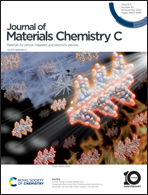A study of the optical properties of wide bandgap oxides for a transparent photovoltaics platform†
Abstract
Transparent photovoltaics (TPVs), a see-through energy production platform that allows visible light to pass while absorbing harmful ultraviolet light, is the backbone of invisible onsite power generation. To improve the performance of TPV devices, insight into the optical properties of the transparent absorber layer and device operation is required. In this study, a TPV device based on a transparent n-type absorber (ZnO, anatase-TiO2, and rutile-TiO2)/p-type NiO heterojunction is prepared, using magnetron sputtering, offering onsite power and an eco-friendly framework. The optical bandgaps and optical constant of the transparent absorbers are examined by ellipsometry. The effect of the dielectric constant values of the absorber layers on the device performance is investigated. All fabricated TPV devices exhibited high optical transparency (>55%) in the visible region, high sensitivity to ultraviolet lights, and self-powered behavior. It was found that n-type wide-bandgap absorbing films (anatase-TiO2), with a higher dielectric constant, are more suitable for heterojunction formation with p-type NiO films due to better charge transfer and less recombination. The TiO2 TPV device showed an average visible transmittance of 60% and a power conversion efficiency of 6% under 365 nm illumination (50 mW cm−2). Furthermore, the Mott–Schottky characterization of the TPV devices revealed the flat-band potential and effective carrier density under dark and illumination conditions, which permits a better understanding of the underlying physical significance of oxide-based transparent optoelectronics.



 Please wait while we load your content...
Please wait while we load your content...